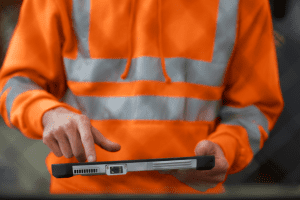The future of field service
The Record Issue 1: Summer 2016
Microsoft is bringing the power of the internet of things to customer service through its Connected Field Service solution and Microsoft Dynamics CRM platform. With more power in the hand of the workforce than ever before, what might the future hold?

In an increasingly connected world, companies are looking to deliver increasingly personalized, proactive and predictive experiences. Engaging customers and empowering employees is at the heart of the digital transformation that organizations across the world are undergoing to differentiate themselves from the competition.
Earlier this year, Microsoft launched its latest wave of Dynamics CRM, which included the new Connected Field Service solution. Now available in preview, according to Param Kahlon, GM of Program Management, Microsoft Dynamics CRM, the Connected Field Service solution ‘provides out-of-the-box internet of things (IoT) to field service capabilities, so IoT enabled devices are continuously monitored and anomalies are detected, generating alerts that trigger automated actions or service tickets and workflow according to service level agreements.’
With the solution, the availability and proximity of service technicians with the right skills and tools are matched against the service requirement and routed to customer locations to take preventive action.

“This represents a truly revolutionary shift from more of a reactive break-fix posture, to a model that is built on predictive service,” Kahlon explains. “These proactive companies will be focused on outcome driven service, as opposed to work order billing business models.”
With the potential to radically alter the service paradigm, connected field service as a concept is something more companies are sitting up and taking notice of. But Microsoft’s recent launch is simply the first step. The future of connected field service is full of possibilities.
Microsoft identifies five key exciting areas that could feature in the future of connected field service.
The first is wearables. Unlike many industries, in field service having technology integrated into clothing is potentially advantageous. Smart glasses could show wearers information about specific customers while on site. Health monitors could warn employees about overexertion. Safety monitors about potentially dangerous environments could help protect employees.
Another area is unmanned vehicles, such as self-driving cars or drones. With a self-driving car, a technician has more time to focus on their next appointment or brush up on details about a machine they are going to service. Drones could be used to help with tasks such as infrastructure monitoring, aerial mapping and thermal imaging to detect equipment overheating.
A number of field service solutions that harness the power of virtual reality have started to emerge. Automotive manufacturer Ford, for example, is delivering virtual assembly training for field service technicians using virtual reality headsets.
A fourth area is augmented reality, which centers around enhancing a users’ interaction with the real world. HoloLens, Microsoft’s augmented reality headset, is now being used in the field service space, and Microsoft has worked with Trimble to create new applications for the architecture and construction industries.
A final and perhaps most controversial area is robotics. The automation possible from the use of robotics could have implications for field service sector. Robot technicians could replace human technicians doing routine maintenance jobs, but robotics could also be used for training purposes and automating back-office processes.
These key areas could have a radical effect on companies’ field service key performance indicators, with first time fix rates, billable hours, overtime hours and employee productivity poised to change how companies and organizations approach field service management, and crucially move towards business growth.





